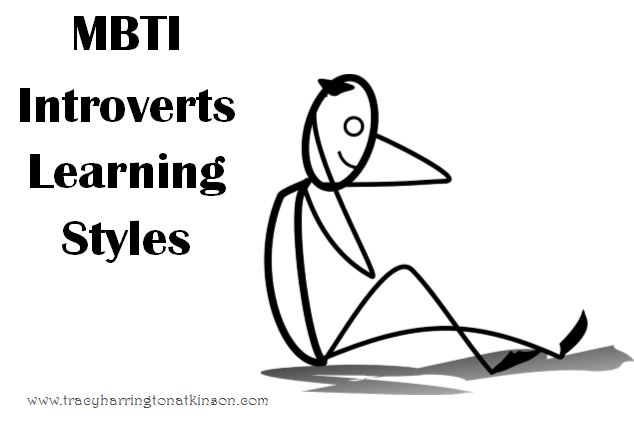Introversion Learning Style
Where do you put your attention and get your energy? Do you like to spend time in your inner world of ideas and images (Introversion)?
_______________________________________________
Frequency
Extraversion (E) 49.3% of the total population
Introversion (I) 50.7% of the total population
_______________________________________________
The estimated frequency table was compiled from a variety of MBTI® results from 1972 through 2002, including data banks at the Center for Applications of Psychological Type; CPP, Inc; and Stanford Research Institute (SRI).
Learner Keyword: Reflective
Learner Question
Introverts, while learning, address the question, “Will I receive sufficient time to reflect on this information?”
Learning Style
Introverts (I) are energized through quiet times of reflection to integrate new information and knowledge into existing schemas through scaffolding. Quiet is the keyword for the introverted learner as they focus on mental processing and observation.
Introverts desire to be understood but often lack the ability to speak up, sharing their impressions, thoughts and connections. They will figure out things and process completely before talking and sharing what they know.
They enjoy observing and listening. They will study for long stretches without need for interruptions and breaks. Working independently is their strength.
Cognitive Environment
Introverts prefer a quiet learning environment where they have plenty of opportunities for reflection and contemplation. Independent learning and studying are strengths. Silence and thought provoking questions guide the introvert in their scaffolding process.
Introverts can be social while learning, working with a partner but will still need space, time and quiet to recharge. They will observe a process before participating.
Lectures and providing examples work well for them. They will tend to excel in reading and written work.
Introverts are most comfortable:
- Understanding the learning standard required of them.
- Observing
- Listening
- Describing something rather than acting it out
- Reading, lectures, written work
- Studying independently and in quiet
- Having substantial time to reflect
For other learning styles: MBTI Learning Styles – A Practical Approach Available in paperback; Kindle; and pdf versions
Introverts are least comfortable:
- Being the center of attention
- Learning in noise and confusion
- Having frequent breaks during their study time
- Demonstrating
- Oral work and discussions
Learn More:
For more information on teacher and classroom tips, learner tips, instructional strategies and assessment strategies, see MBTI Learning Styles: A Practical Approach or learn more on Udemy.
Click on one of the sixteen personality types for more information:
Click on one of these dimension for more information:
For other learning styles: MBTI Learning Styles – A Practical Approach Available in paperback; Kindle; and pdf versions
References
Bonwell, C. & Eison, J. (1991). Active Learning: Creating Excitement in the Classroom. ERIC Digest. ERIC Clearinghouse on Higher Education, Washington, D.C
Career Assessment. (2017). The 16 Myers-Briggs Type Indicator Personality Types (MBTI personality types). Retrieved from: http://careerassessmentsite.com/tests/myers-briggs-tests/about-the-myers-briggs-type-indicator/the-16-myers-briggs-personality-types/
CPP, Inc. (2017). Linking MBTI® Personality Type to Learning Style – Strategies and Insights. Retrieved from: http://www.cppblogcentral.com/cpp-connect/linking-mbti-personality-type-to-learning-style-strategies-and-insights/
Defiance College. (2106). What’s Your Personality Type? Retrieved from: http://library.defiance.edu/learningstyles/myersbriggs
Gregory, G. (2008). Differentiated instructional strategies in practice: training, implementation, and supervision (2nd ed.). Thousand Oaks, CA: Corwin Press. p. 97-99.
Humanmetrics. (2017). Learning Styles. Retrieved from: http://www.humanmetrics.com/personality/learning-styles
Kiser, H. (2017). Choice board. Retrieved from: https://hillarykiser.blogspot.com/2012/10/choice-board.html?showComment=1491939410939#c9063789945839625994
Krafka, K. (2017) Learning Menus. Retrieved from: http://prescriptionforgiftedsuccess.weebly.com/learning-menus.html
Litemind. (2017). What is mind mapping? Retrieved from: https://litemind.com/what-is-mind-mapping/
Martinez, M. (2006). What is metacognition. Phi Delta Kappan, 64(10), 696-699.
Melvin, J. (2017). Personality Type as an Indicator of Learning Style. University of Rochester. Retrieved from: file:///C:/Users/Tracy/Downloads/JMelvinSGf13paper%20(2).pdf
Myers & Briggs Foundation. (2017). How frequent is my type? Retrieved from: http://www.myersbriggs.org/my-mbti-personality-type/my-mbti-results/how-frequent-is-my-type.htm
Myers & Briggs Foundation. (2017). Type and Learning. Retrieved from: http://www.myersbriggs.org/type-use-for-everyday-life/type-and-learning/
Myers, I. (1998). Introduction to Type: A Guide to Understanding Your Results on the MBTI Instrument. Consulting Psychologists Press.
Myers, I., McCaulley, M., Quenk, N. & Hammer, A. (2009). MBTI Manual: A Guide to the Development and Use of the Myers-Briggs Type Indicator Instrument. Consulting Psychologists Press.
Okoro, C. & Chukwudi, E. K. (2011). Metacognitive skills: A viable tool for self-directed learning. Journal of Educational and Social Research, 1(4), 71-76.
Pelley, J.W. (2008). The Success Types Learning Style Type Indicator. Retrieved from: Texas Tech University. https://www.ttuhsc.edu/som/success/lsti.aspx
Smith, C. V. & Cardaciotto, L. (2011). Is active learning like broccoli? Student perceptions of active learning in large lecture classes. Journal of the Scholarship of Teaching and Learning, 11(1), 53-61.
University of Texas. (2017). Experiential Learning. Retrieved from: https://facultyinnovate.utexas.edu/teaching/strategies/overview/experiential-learning
Western Nevada College. (2017). Personality Types and Learning. Retrieved from: http://www.wnc.edu/mbti/personality-types/
Tracy Atkinson is certified in Myers Briggs Type Indicator (MBTI) by CPP, Inc. The findings on learning styles derive from research, experience and observations.
Tracy Atkinson, a mother of six, lives in the Midwest with her husband and spirited dachshunds. She is a teacher, having taught elementary school to higher education, holding degrees in elementary education and a master’s in higher education. Her passions include researching, studying and investigating the attributes of self-directed learners. She has published several titles, including: The Art of Learning Journals, Calais: The Annals of the Hidden, Rachel’s 8 and Securing Your Tent. She is currently exploring the attributes of self-directed learners: The Five Characteristics of Self-Directed Learners.



Comments are closed